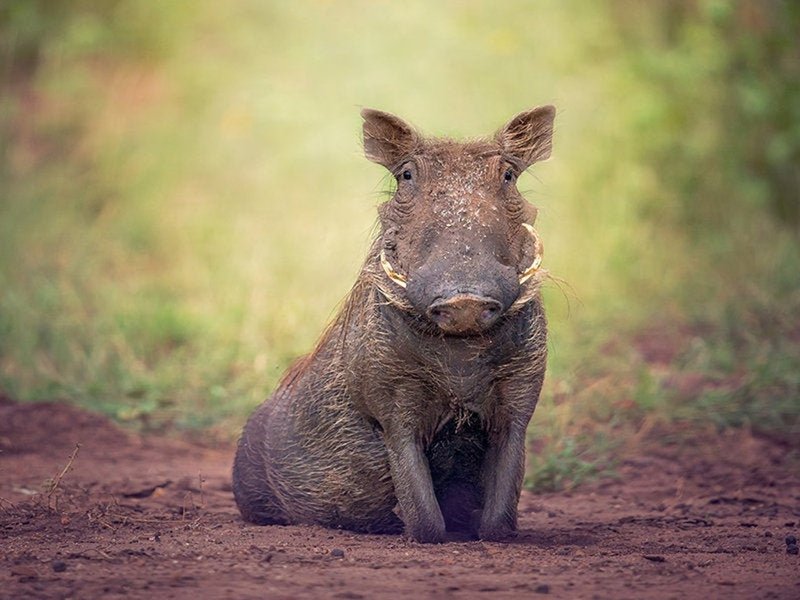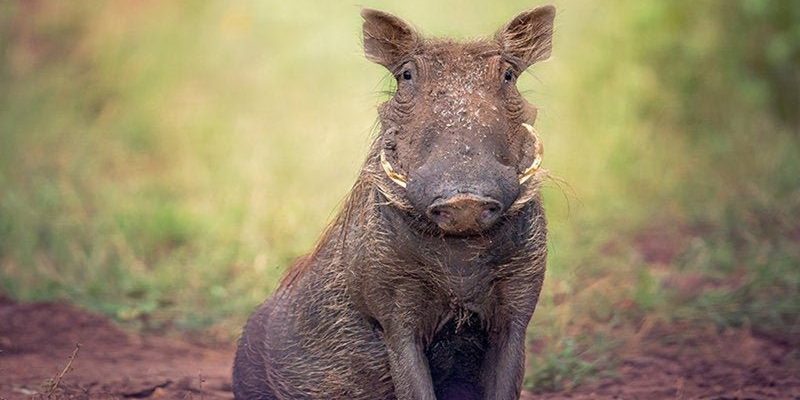
It’s essential to know that warthogs are generally not aggressive unless they feel threatened. Picture them like a spiky ball of energy that prefers to root around for food rather than charge at you. If you keep your cool and know the right steps to take, you can safely enjoy the encounter without any drama.
Understanding Warthogs: The Basics
Warthogs are wild members of the pig family, known for their distinctive tusks and rugged appearance. They have a thick body and short legs, which make them look a bit clumsy, but don’t be fooled! These animals are quite agile. They mainly inhabit grasslands and savannas and are often seen grazing on grass or digging for roots.
You might be surprised to learn that warthogs can actually run at speeds of up to 30 miles per hour. That’s faster than most humans can sprint! When feeling threatened, these creatures tend to flee rather than fight, which is something to remember during your encounter.
Stay Calm and Observe
If you spot a warthog, the first thing to do is to stay calm. It’s easy to feel a rush of adrenaline when you see wildlife up close, but remember that they can sense your energy. Keep your movements slow and steady.
Take a moment to observe the warthog from a distance. Are there other warthogs around? Is it eating or resting? This can give you clues about their behavior. Warthogs often stay close to their burrows, which they dig themselves or adapt from other animals’ dens.
While you’re observing, make sure to enjoy the moment. These creatures are a part of a larger ecosystem, and watching them interact with their environment can be a unique experience. Just remember not to get too close!
Keep Your Distance
When encountering a warthog or any wild animal, it’s crucial to respect their space. Ideally, you should stay at least 50 yards away. This distance allows you to enjoy the sight while also keeping yourself and the warthog safe.
Warthogs may feel threatened if you get too close, and while they typically prefer to run away, they can defend themselves if cornered. Their tusks are sharp and can cause serious injuries. If the warthog looks agitated or starts to stomp its feet, that’s your cue to back off.
Using binoculars can enhance your viewing experience while keeping you at a safe distance. Just think of it as your personal window into their world!
Do Not Approach or Feed
No matter how tempting it may be, **do not** approach or try to feed a warthog. These animals have a natural instinct to forage for their food, and feeding them can alter their behavior, making them reliant on humans.
Additionally, wild animals can carry diseases that could be harmful to humans. Keep in mind that a warthog is not a domestic pet, and trying to interact with one could lead to unwanted situations.
If you find yourself too close, slowly back away while keeping your eyes on the warthog. This is not only respectful to the animal but also an essential safety measure for you.
Know How to React If They Charge
While warthogs are generally docile, there might be rare instances when they feel threatened and charge. If this happens, try not to panic. Here’s what you can do:
- **Stay still:** Sometimes, remaining stationary can help. The warthog may lose interest and move away.
- **Find shelter:** If there’s a vehicle or a tree nearby, retreat to a safe spot.
- **Back away calmly:** If the situation allows, back away slowly without turning your back to the animal.
Remember, warthogs would much rather escape than confront a threat. Your goal is to remain out of their way and avoid escalating the situation.
Take Precautions for Your Safety
Being prepared before your wildlife adventure is vital. Here are some precautions you can take to ensure your safety:
- **Know your surroundings:** Familiarize yourself with the area you’re exploring. Are there known warthog habitats nearby?
- **Travel in groups:** If possible, stick with fellow travelers. There’s safety in numbers.
- **Stay informed:** Learn about local wildlife and guidelines, especially in national parks or reserves.
Taking these precautions ensures you can enjoy observing warthogs without unnecessary risk.
Capturing the Moment Responsibly
If you’re keen to snap some photos of the warthog, make sure to do so responsibly. Use a zoom lens if you have one, maintaining a safe distance while still capturing lovely images.
Avoid using flash photography, as it can startle the animal. Instead, let the natural light work its magic. When taking pictures, focus more on the experience and the environment rather than just getting the perfect shot.
Remember, your encounter is a chance to witness nature at its best. Enjoy the moment, and share your stories with others to inspire them to respect wildlife too.
Encountering a warthog in the wild can be one of those unforgettable moments that you’ll remember for years. By staying calm, keeping your distance, and respecting their space, you can enjoy the unique opportunity without putting yourself or the animal at risk.
Every wild encounter is a reminder of our connection to nature. So the next time you find yourself in the presence of these remarkable creatures, remember these tips. Not only will you be safer, but you’ll also get to appreciate the beauty of wildlife in its natural habitat. Keep exploring, and happy adventuring!

